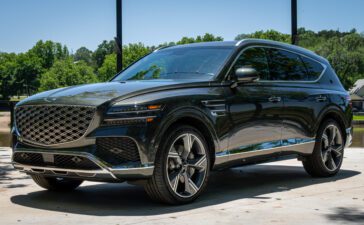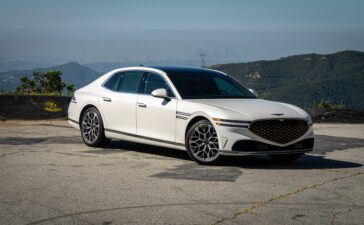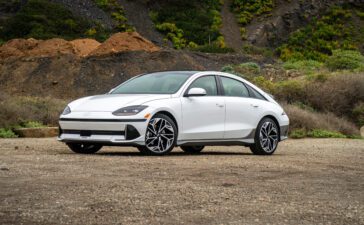Ever since the EV1 of the late 1990s, General Motors has led the pack in forward-facing electric vehicle production. That first foray into electrification suffered an ignominious fate, sure, but soon enough, the Chevrolet Volt and then the Bolt carried on GM’s EV mantle—which most recently resulted in the absurdly gargantuan revival of the Hummer as a fully electric brute capable of crab-walking and four-wheeling alike. To an extent, the Volt, early Bolts, and especially the six-figure Hummer EV can be considered niche vehicles. Now, with the debut of a fully-electric 2024 Chevrolet Blazer EV, Chevrolet purposefully designed and engineered a crossover built for the purpose of converting a wider swath of EV holdouts.
The newly electrified Blazer joins two gasoline engine options to create a full run of eight different powertrain variants, even before selecting various trim and options packages. Is that too much for consumers? Well, at a recent media drive program in the hills of San Diego, Chevy introduced the new EV in a perfect setting to show off attractive design and impressive driving dynamics, as well as solid proof for every EV’s most important stat: real-world range.
Skip to section:
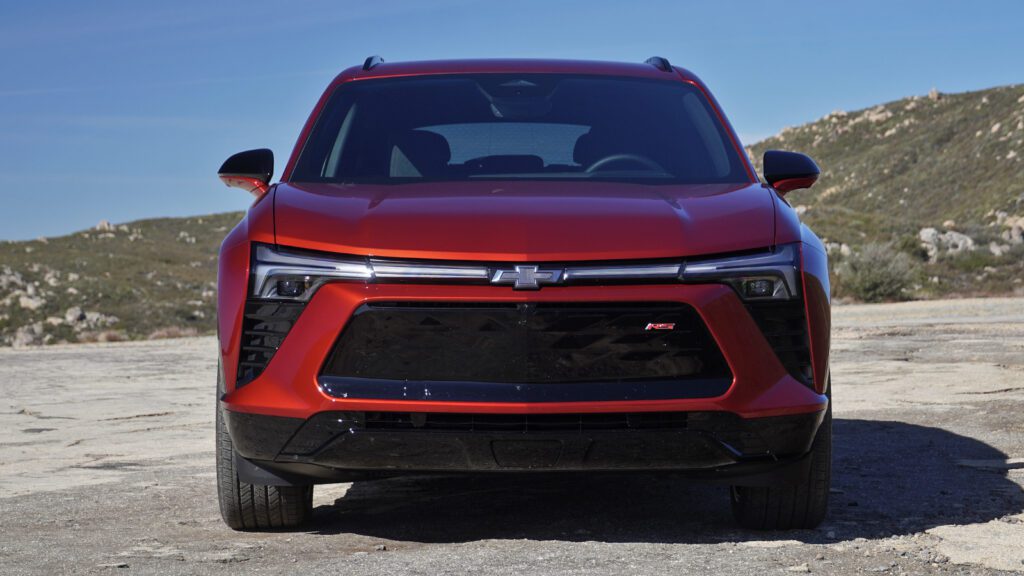
Price and specs
Note that not every tidbit of information is currently available at the time of publishing. MPGe for front or rear-drive variants are yet to be revealed on the fuel economy.gov website, and exact performance measurements are yet to be tested. Thankfully, this first drive event still gave us more than a clear enough view of what to expect from the Bowtie’s forthcoming cyberpunk soccer practice shuttle.
[Button id=”490″]
| Base price: | $44,995 (minus rebates) |
| As-test price: | $60,215 (2RS AWD minus rebates) |
| Electric motor options: | dual motor, front bar-wound, rear induction without magnet |
| Transmission: | single-speed direct drive |
| Drivetrain options: | front-wheel drive, rear-wheel drive, all-wheel drive |
| Power: | 288 hp/212 kW combined (2RS AWD), 340 hp available for RWD, up to 557 hp (SS) |
| Torque: | 333 lb-ft/451 Nm combined (2RS AWD), 325 lb-ft available for RWD, up to 648 lb-ft (SS) |
| Weight: | TBA |
| Zero-to-60 mph: | TBA; approx. <4 seconds (SS) |
| ¼-mile: | TBA |
| MPGe: | TBA (FWD, RWD), 103 city, 88 highway, 96 combined (AWD) |
| Battery Capacity: | 85 kWh (102 kWh available) |
| EPA Range: | 279 miles (up to 324 miles available) |
| Charging: | 150 kW DC fast charging (up to 190 kW available) |
| 10-min fast charging capability: | 69 miles (RS AWD), 79 miles (RS RWD) |


Exterior design
From more than 50 feet away, the ICE and EV Blazer siblings look nearly indistinguishable. But up close, GM’s Ultium chassis beneath the skin clearly allowed Chevrolet to scoot the wheels further out towards the EV’s corners, which creates a sportier form highlighted by slightly swoopier aero lines. Large 21-inch wheels, Y-shaped taillights, and an optional front light bar on highly equipped versions help to add a stylized futurist aesthetic in contrast to the more restrained ICE design.
Overall, the almost Mazda-esque shape comes together best on white, black, and silver Blazers, though some of the details add up to make brighter metallic colors a bit showy. A host of piano black plastic cladding, so popular on EVs these days, detracts from otherwise clean lines and fades away best when camouflaged by simpler paint jobs.
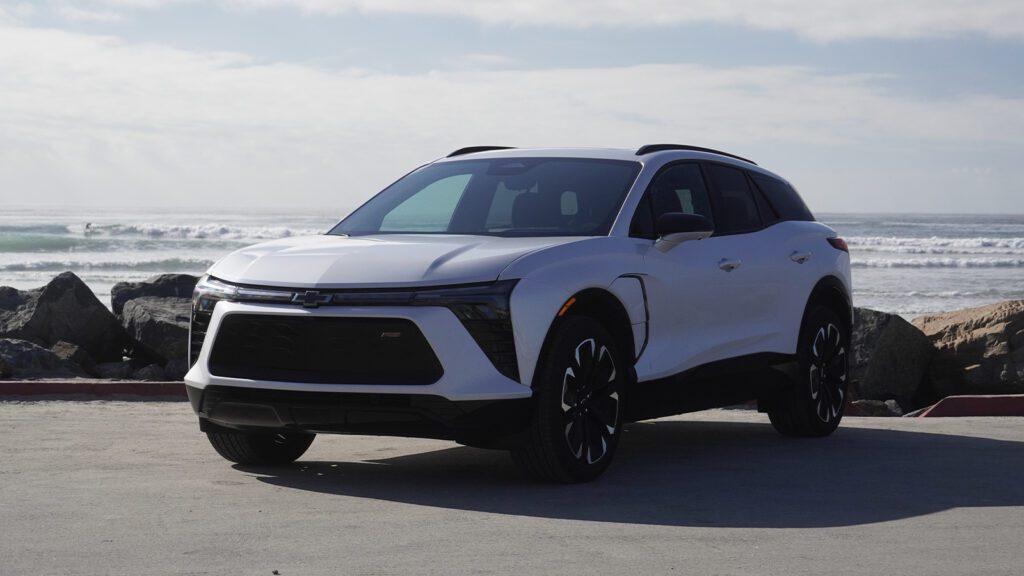
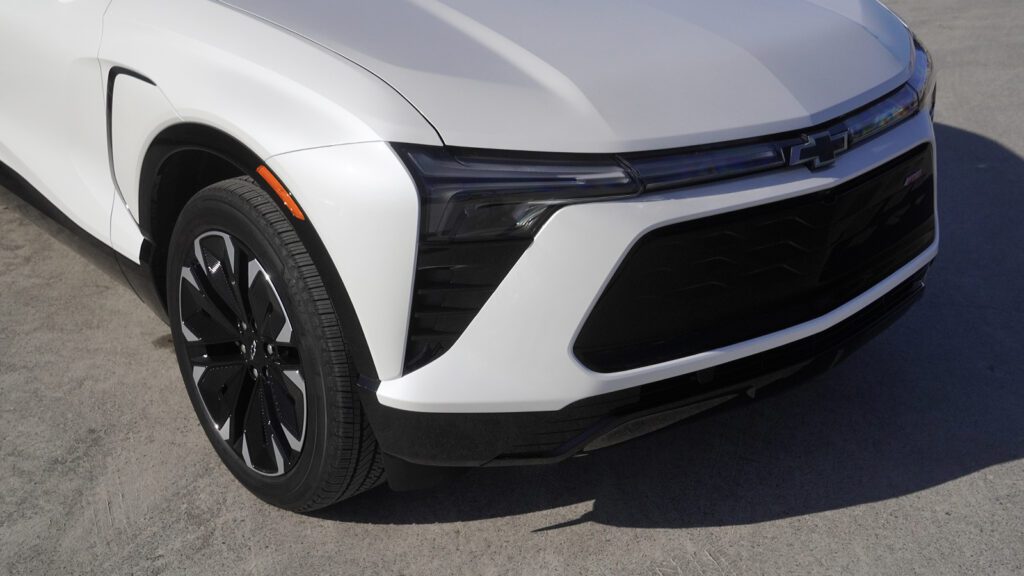
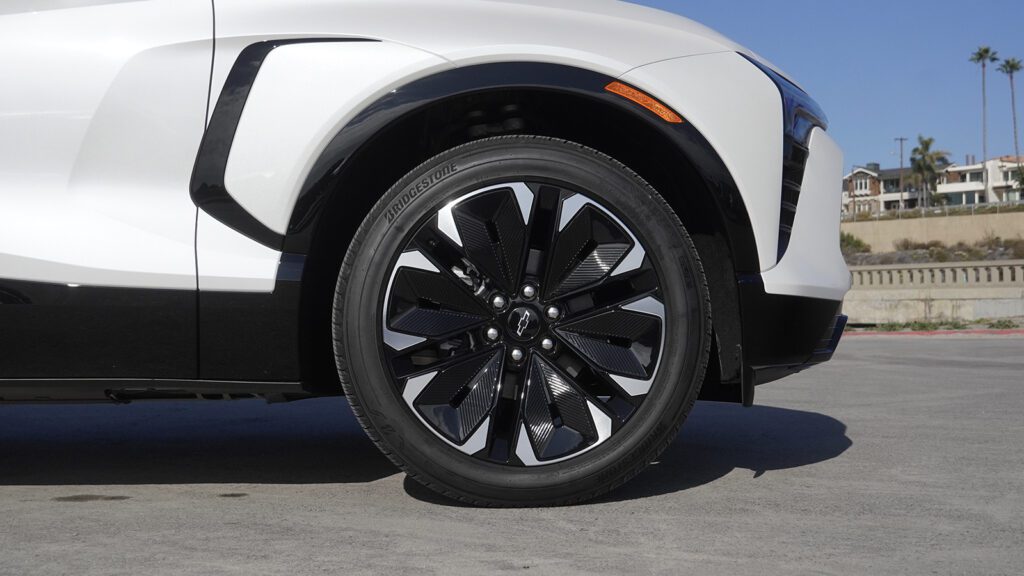


| What’s hot? | – Sporty and smooth driving dynamics for an electric crossover – Prioritizing NVH makes the EV experience much more palatable – Tech galore on a class-leading touchscreen – Easy to just get in and drive |
Chevrolet Blazer EV pricing breakdown
Chevrolet promised earlier this year that a base 1LT model Blazer EV would start at $44,995 minus any rebates and incentives, but the RS AWD trim on hand in San Diego ratchets that price tag up to just above $60,000 quite quickly. Filling mid-level slots in the gradewalk, the 2LT and RS FWD will cost $47,595 and $51,995, respectively.
Production of the AWD Blazers began in the summer, but other trims will begin assembly soon. Meanwhile, the highest-performance SS package offering 557 horsepower and 648 lb-ft of torque will be priced at $65,995, with deliveries slated for later in 2024.
Chevrolet Blazer EV interior and tech
Pushing all four wheels towards the Blazer’s corners only accentuates this EV’s interior volume. Four full-sized adults will fit with plenty of head and legroom, all without impinging on a best-in-class 59.8 cubic feet of rear trunk capacity (with the back seats upright). Beneath the trunk floor, a small cargo hold adds to that figure, flanked by flat tire kits in place of a full-size spare.
The interior design features fun retro-themed climate vents plus a fair amount of piano key switchgear and physical knobs, but the entire experience centers around a massive 17.7-inch panoramic touchscreen atop the dash. Plenty of adjustable drive mode settings and EV-specific navigation tools work seamlessly with Google’s Built-In program and Wireless Apple CarPlay and Android Auto functionality, of course.



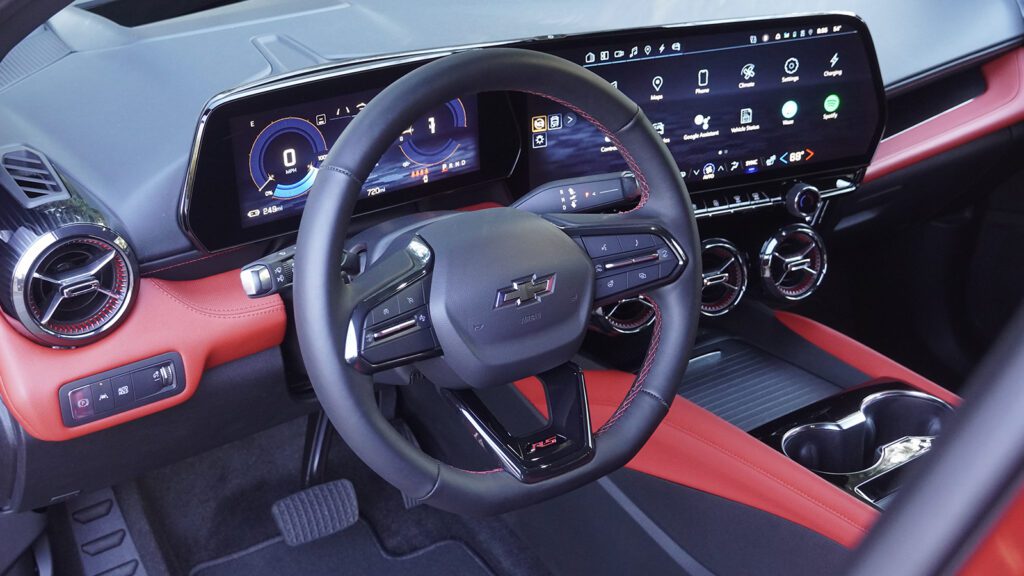
In fact, the Blazer EV dash can house up to four screens counting the main center display, the driver’s gauge cluster, a standard Head-Up Display, and an optional digital camera rearview mirror. Both the main touchscreen and gauge cluster allow for easy configuration and prioritization of common widgets, including an easy way to switch headlights on and off, plus even an off button for the whole vehicle (which so many EVs frustratingly lack).
Surprisingly, the higher RS package does not offer a panoramic roof, though the lower-spec LT trim does. The RS gets ventilated seats standard, however, which is an important detail on EVs given that less efficient air conditioning for the whole cabin can affect range so significantly. Whether most buyers select the undeniably excessive red upholstery seems dubious, though Chevrolet’s loaner fleet will highlight that package for eye-catching media photos.
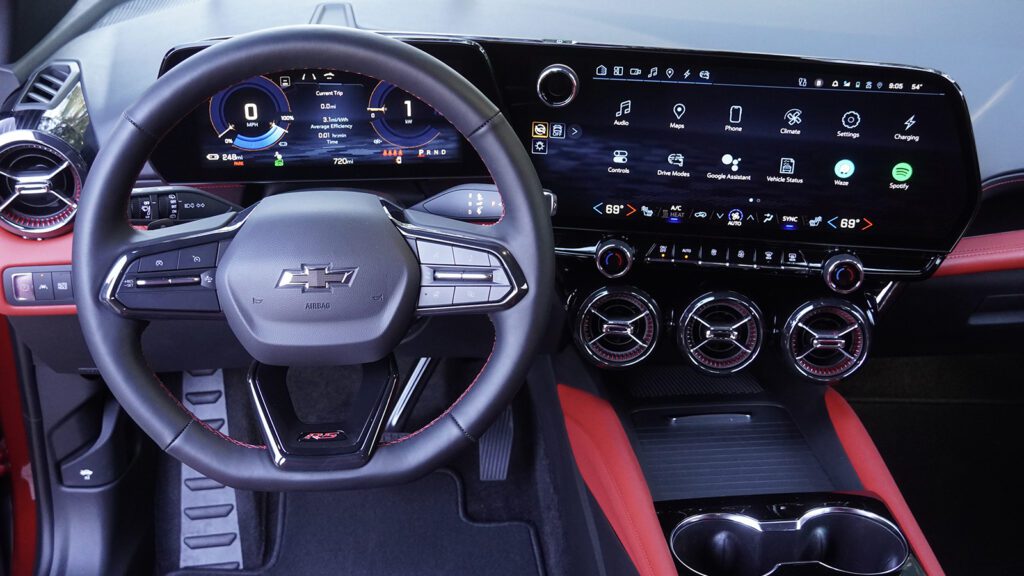
Smooth (and sporty) operator
Chevrolet first set journalists loose to explore San Diego in a fleet of the rear-wheel-drive RS variants, which use a single 250-kilowatt motor putting down the equivalent of 340 horsepower. First impressions on a series of winding sweepers showed off the Blazer EV’s impressive chassis dynamics, which toe the line between smooth and sporty with minimal body roll thanks to the low-slung Ultium skateboard.
Punching the go pedal (can’t call it a throttle, after all) produces a quick moment of jerk (the scientific term for rate of change of acceleration, I’m serious) but never the same kind of rollercoaster stomach lurch as other high-performing electrics. “Peppy” describes the rear-wheel-drive RS best, but straight-line speed probably takes a second-row seat to its cornering and confidence. A thick steering wheel rim accentuates that athletic nature, with a surprising amount of weight and feedback for an adjustable electronically assisted rack.
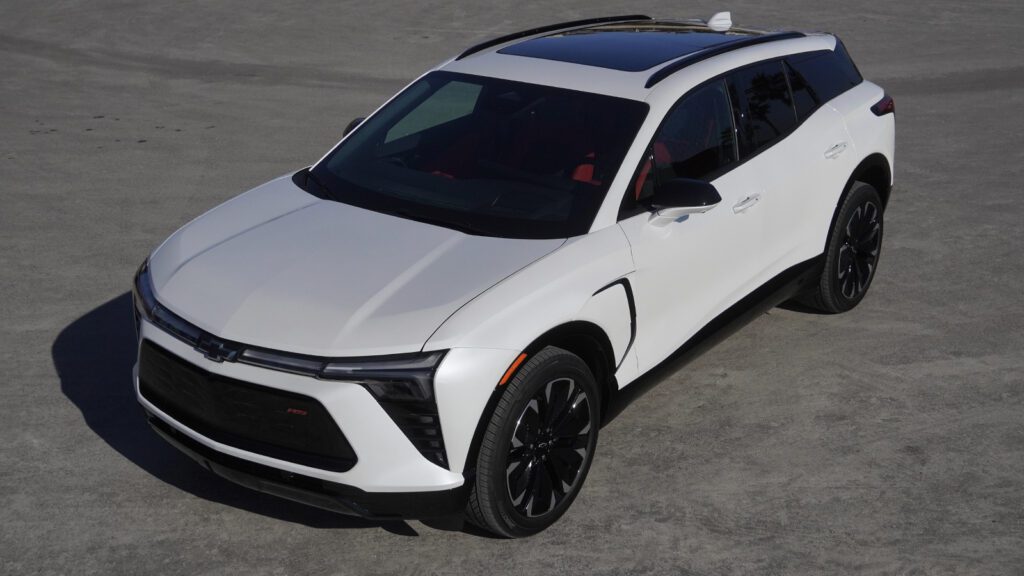
Switching through various drive modes changes the level of steering assist, as well as acceleration tip-in, brake pedal response, and faux engine sounds. Acclimating to the maximum one-pedal drive mode takes some time before neck-snapping at liftoff smooths out, but luckily a lower level of regen is easily selectable, as well. A configurable “My Mode” allows for a better balance between the various settings, critically to entirely switch off the silly fake engine noises.
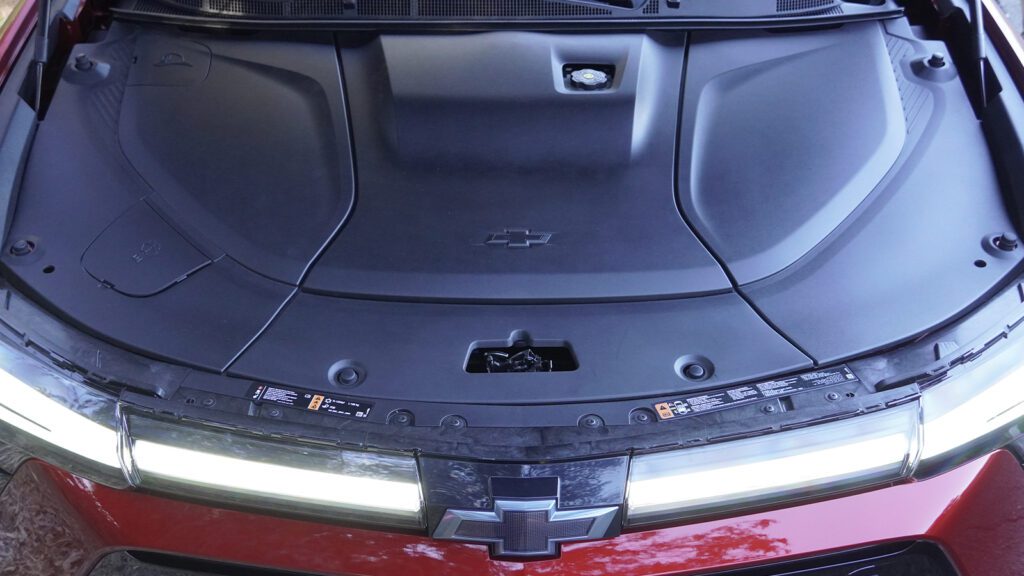
All-wheel zap!
The next morning included far more drive time behind the wheel of an all-wheel-drive RS, which to the general confusion of everyone involved, actually combines for significantly less output than the single-motor rear-drive version. So yes, you read the above spec table correctly. In this case, a front 180-kW motor pairs with a small 67-kW helper motor at the rear axles to create a combined rating of only 288 horsepower, although max torque does increase to 333 pound-feet. That helper motor gives a bit of punch while cornering or on low-traction surfaces, but for the most part, the larger front motor handles power delivery, likely a concession to improved efficiency and, therefore, range.
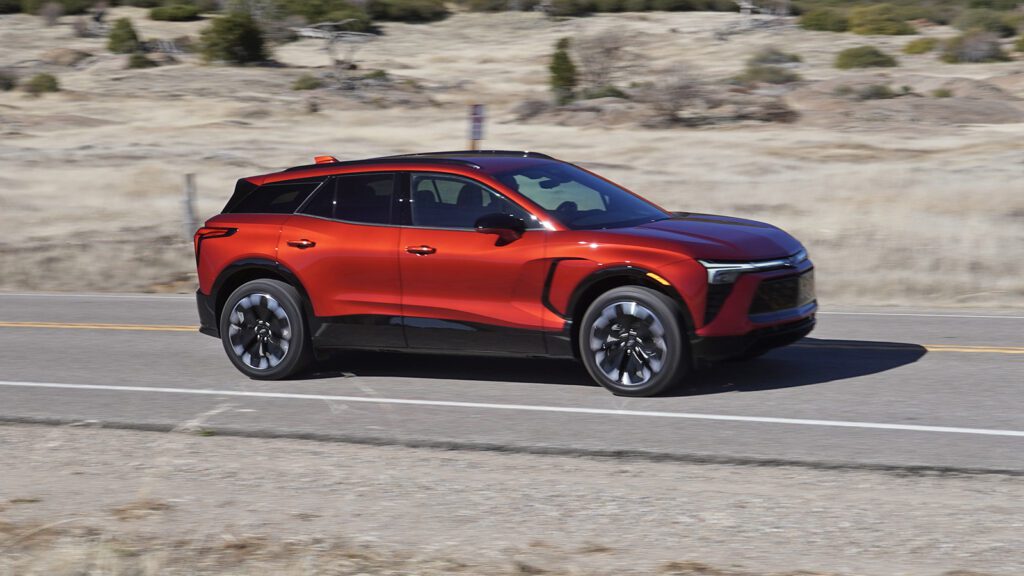



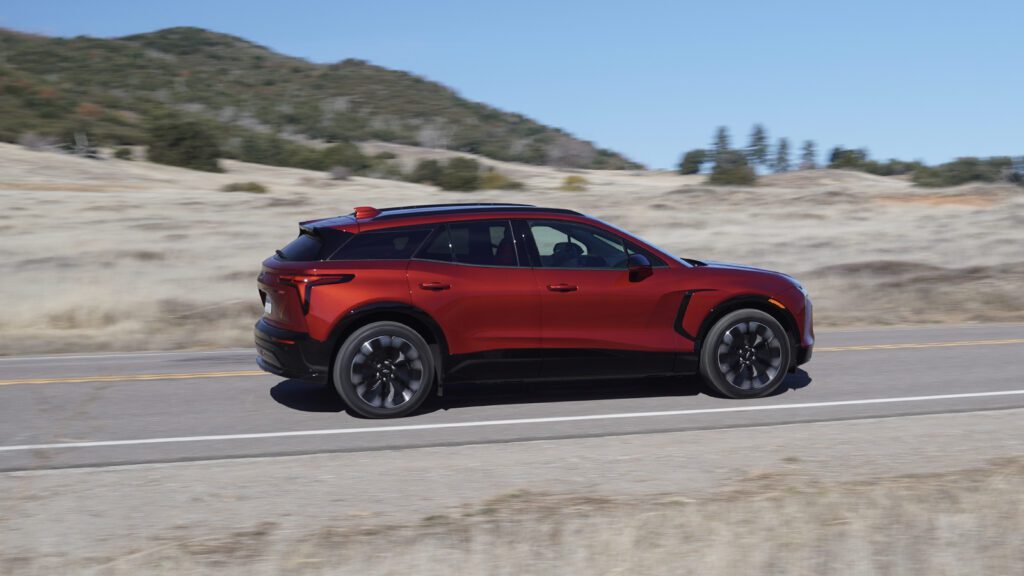
The AWD RS similarly rides smooth and quiet, with plenty of pickup available up to around 50 miles an hour where pushing air starts to impinge on outright shove. Even running through canyons near Julian, California, where the composed suspension served as the star of the show, that questionable powertrain layout produced minimal torque steer despite its front-biased setup. Most importantly, while climbing 6,000 feet of elevation and then cruising back to sea level with plenty of journalistic exuberance and the A/C blasting, the AWD RS only pulled about 150 miles out of the fully charged 85-kWh battery to drive the full route’s 143-mile distance.



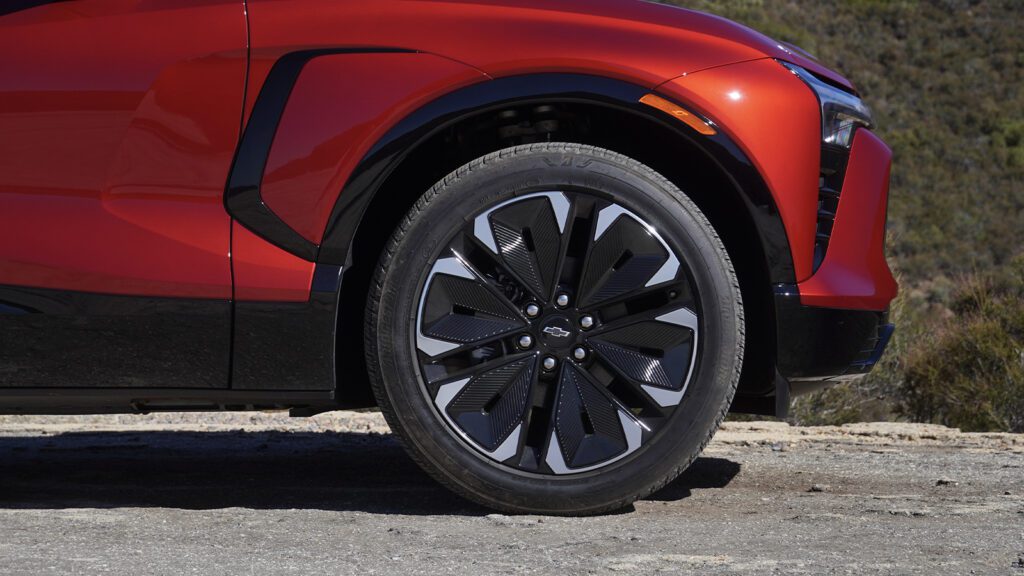

As posh and quiet as an EV should be
Not bad, Blazer. Not bad at all, and a good sign for the larger Ultium 102-kWh Ultium battery pack that will offer the option for an EPA-rated 324 miles of range. But probably the most impressive aspect of the Blazer EV can easily go unnoticed: the very hard work that GM put into reducing Noise, Vibration, and Harshness (NVH).
A square set of low rolling resistance Bridgestone Alenza A/S “Enliten” tires measures a respectable 275 millimeters wide at all four corners yet produces very little road hum even up to nearly triple-digit speeds. Mounting tires that wide on 21-inch wheels helps to minimize drag and maximize range but also contributes to the unshakeable stability of the Blazer while cornering hard in an effort to explore the limits of Chevy’s traction control and ESC programming. Only the occasional squeal of protest pushed the limits of the eco-focused rubber, and yet intervention by robot overlords never approached the edge of intrusiveness that many other electric powertrains struggle to exercise effectively.
The pre-production RWD RS did rattle a bit from the back seats, as perhaps expected. But the production version of the AWD RS almost approached Lucid levels of silence, an important factor due to the lack of an internal combustion engine to drown out little creaks and clunks. Similarly, while either ripping through canyons or rolling down the highway with adaptive cruise control on, minimal wind noise entered the cabin. (Of note: the Blazer EV will include an option for GM’s impressive Super Cruise Level 2+ autonomous driving system that works on over 400,000 miles of American roadway.) Even with the respectable sound system playing country music on low volume, the entire drive bordered on serene, which clearly points to the benefits that legacy automakers bring to the table when building mass-scale electric vehicles.



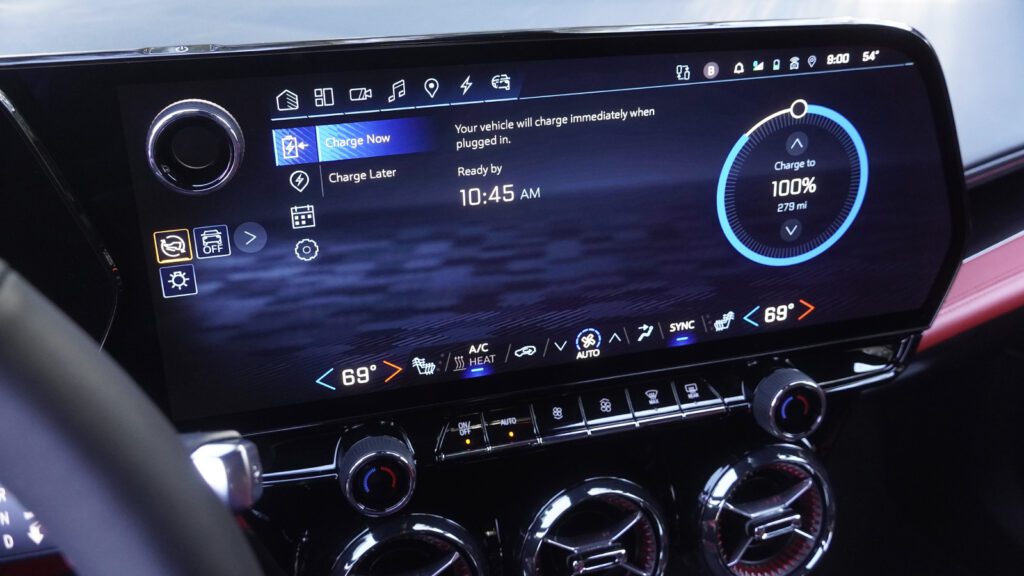
| What’s not? | – Priced surprisingly high for a General Motors EV – Exterior design can look busy on certain colors – Electric range lagging behind industry leaders, including GM’s own Hummer and forthcoming Silverado |
A fine electric crossover in a fiercely competitive battlefield
Will customers find the dizzying range of choices between three different drivetrain layouts—FWD, AWD, and RWD—plus the two battery sizes and unexpected output ratings, not to mention the duo of gasoline Blazers, simply too extensive to make an educated decision? Paralysis by analysis seems likely, and the RS nomenclature seems a bit odd for a low-spec front-biased all-wheel-drive layout. Navigating the configurator on Chevy’s website will almost require a spreadsheet.
And then the pricetag for the RS AWD, at $60,215 as tested, somehow ends up higher than a more luxurious, more eye-catching Cadillac Lyriq. Maybe GM is banking on the fact that most customers who wanted a bold EV will flock to the Caddy’s obviously futuristic styling, while the target base for Blazer will lean more towards conservative shapes and lines. Either way, reps on hand in San Diego believed the Blazer EV would also qualify for federal and local rebates, given GM’s massive investments into American manufacturing.
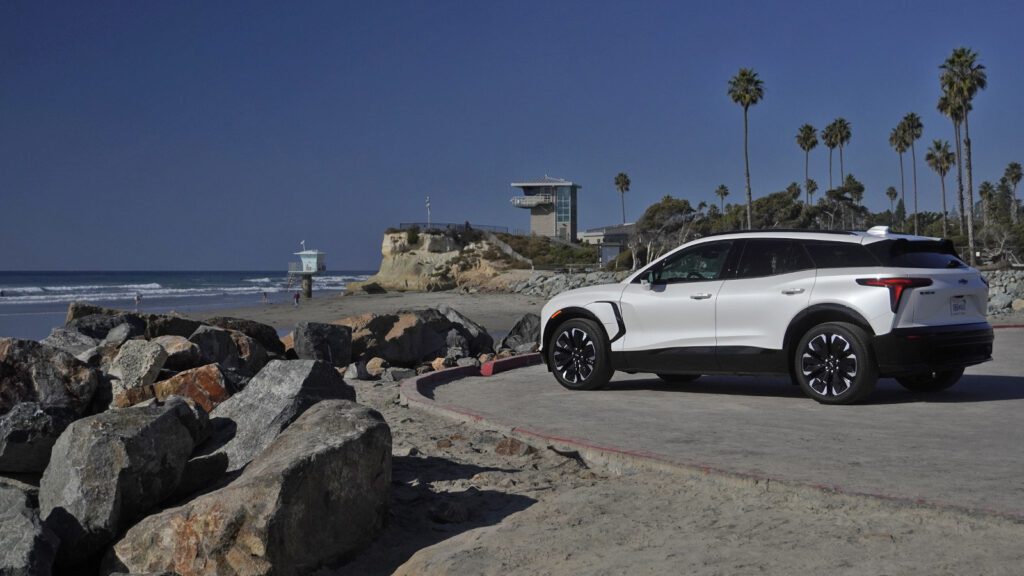
Still, after the Bolt and its EUV variant snatch up the lower end of the EV market, while the Hummer EV and forthcoming Silverado EV offer so much more range, the Blazer’s pricing and spec gradewalk might have been the biggest surprise of the entire San Diego experience. Anyone expecting performance on par with Teslas and Lucids—or even Hyundai and Kia’s higher-performance Ioniq 5 N or EV6 GT—will need to wait for the SS next year and prepare to shell out stacks of cash for the matching front and rear motors to truly max out the Blazer chassis. In the meantime, the lower spec Blazers will certainly serve as a wide range of perfectly respectable EV options that can cater to just about any potential buyer priorities and demographics.








